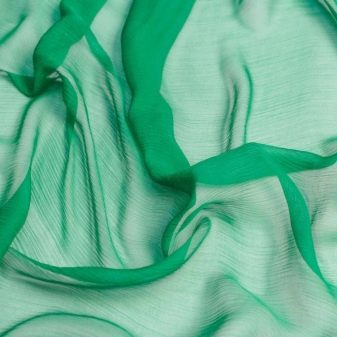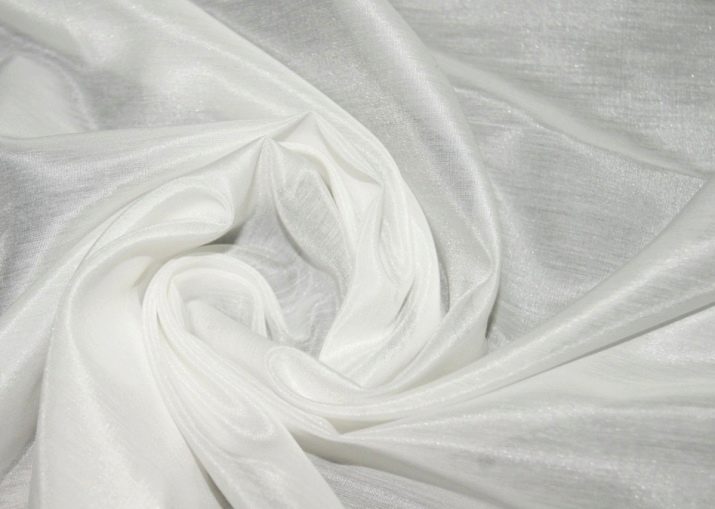All about fine fabrics

Fine fabric perfectly combines oriental ball m and western culture. It drapes perfectly, does not restrict movement and is worn without problems. It is thanks to this that clothes made from such fabric look extremely elegant and suitable for any woman, regardless of her age and physique.


Views
Thin fabric can be of different types, each of which differs in the characteristics of the raw materials used and in different weaves. Among the most popular and demanded are the following:
- Veil... The fabric is renowned for its smoothness, translucency and attractive appearance. The main advantage of the fabric is that it is perfectly ironable, however, you need to be extremely careful when washing. The material is breathable and is often used to make clothing.

- Chiffon - translucent, elegant and soft fabric made of silk and cotton. Very often other threads are added to it, which provides a higher density. Chiffon is actively used to create festive outfits.

- Batiste... Strong, stretch but extremely lightweight fabric that is perfect for blouses and shirts. Plain weave is used in the manufacturing process.

- Chintz... A unique glossy linen fabric made from cotton that is soft and pliable.

- Georgette... This fabric is made from fine twisted yarns, and the plain weave gives it a unique look. The only drawback of the fabric is its granular structure, so you need to carefully select the outfits for the combination.

- Fatin... Mesh stretch fabric that boasts firmness and dirt resistance. It is used to create shawls and scarves.

Features of working with materials
Considering the unique features of fine fabrics, the process of working with them includes many nuances. First of all it is necessary to select the thinnest and longest needles possible. Machine seams are usually made with specialty needles and thread for fine fabrics. The threads should also be selected appropriately, since otherwise they will stand out strongly against the background of the material itself. On the market you can find special yarns that differ in the minimum density.

Careful attention must be paid to the machine stitch length, which should be no more than 0.2 cm. Also, it is best not to sew crosswise, as this creates a lot of tension and can damage the fabric. As a result, defects will begin to appear that negatively affect the strength of the product. The advancement can be improved by placing paper under the fabric to protect the material from damage.

One of the most important points is section processing, which should be carried out by applying a double seam in the hem. In this case, the slice should be as closed as possible. If necessary, you can use a rolled seam. Processing with edging is also used.

Fine fabrics require special handling during ironing. It is imperative to use a special mode that is not capable of harming this type of fabric.
If necessary, it is best to dampen the material with water to protect it from accidental damage.
When wearing a product made of thin fabric, you also need to be extremely careful, since it is quite easy to damage or tear the material. It is best not to make all clothes from a similar material, but to combine it with other, denser counterparts.

What is the thinnest fabric in the world?
More recently, American experts were able to get into the Guinness Book of Records by developing the thinnest fabric in the world. A distinctive feature of this material is that it is only a few nanometers thick. It is 10 times thinner than a human hair.
During the development of the product, thread-like molecules were used, which are connected using carbon and hydrogen atoms. Due to the fact that the threads are intertwined in a perpendicular manner, and the metal atoms and negative ions do not allow them to decay, such a thin fabric is obtained.

With a thickness of 4 nanometers, its density is up to 25 million threads per square centimeter, which is also a record.
It should be noted that despite its size, the new development boasts good strength, which is higher than some polymer filaments. It is because of this that this material can be used as a molecular sieve.

It will be an excellent solution for capturing large and small molecules. Already today, there is an opinion that the thinnest fabric in the world can be used for deep purification of water or other liquid.
Thus, the thin material boasts of its aesthetic properties, comfort and elegance. Given the strength characteristics of this material, it is necessary to handle it carefully so as not to damage it during processing or use.









